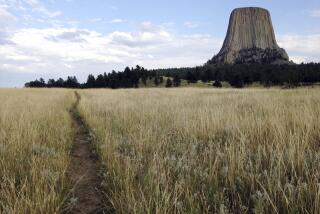Aspiring to the top, while knowing the risks
YOSEMITE NATIONAL PARK — “Live your life that the fear of death can never enter your heart.”
-- Tecumseh, 1809
*
The teachings of the renowned Shawnee chief, regarding attitudes toward death, have held special significance here recently.
A pertinent verse of his was handwritten and pinned to the cluttered bulletin board at Camp 4:
“When your time comes to die, be not like those whose hearts are filled with fear of death, so that when their time comes they weep and pray for a little more time to live their lives over again in a different way.
“Sing your death song, and die like a hero going home.”
Todd Skinner reportedly shared these words with a friend named Ann -- who tacked them onto the board through crimson flower petals --weeks before he plunged more than 500 feet to his death while trying to rappel down a portion of the Leaning Tower monolith.
Skinner was a hero among his peers. His specialty was free-climbing, using gear only for safety but not to aid his ascent. He and Jim Hewitt were practicing for what they hoped would be the first free ascent of a difficult route on the majestic pillar.
The belay loop on Skinner’s harness snapped as he dangled beneath an overhanging ledge. Hewitt later acknowledged that the loop was worn and that Skinner had planned to replace the harness.
A week later, on what would have been Skinner’s 48th birthday, a memorial service was held near his home in Lander, Wyo., where he leaves a wife and three young children.
But time marches on and climbers move forward, not dwelling on death, because to them, the methodical pursuit of the summit, the bonds of friendship and the freedom from civilization are the essence of life.
It was that way for Skinner, who made more than 300 first ascents in 26 countries, and who once lived in a tepee to save money and be close to the rocks he scaled with the seeming ease of a human spider.
And it seems that way for many climbers on a chilly fall morning near season’s end at Camp 4, their seasonal base. Only 20 or so remain and many are emerging from tents, blowing frosty breaths and waving to new acquaintances.
“There’s a sense of camaraderie and companionship that you feel, sitting around a campfire with a dozen other climbers that you never met before,” Nick Wakeman, 26, an unemployed New Yorker, says of this quasi-tribal existence.
“A dozen other climbers that you never met before, but a dozen new places you can travel to, and a dozen other homes that you have to stay in, just from a fireside conversation or a shared rope one day.”
Wakeman met Ben Wilkinson, 27, of Bozeman, Mont. They spent three days trying unsuccessfully to scale the popular Nose route on El Capitan, advancing only 1,200 feet up the 3,000-foot face.
Many come up short on “El Cap,” for obvious reasons.
“The dangers are there, but one thing about climbing is that you can make it as safe or as dangerous as you want,” says Scott Solinko, 22, of Logan, Utah, when asked about Skinner. “Like, if you want to make it dangerous, you can go and free-solo a bunch of big stuff. If you want to make it safe, you can bring a lot of gear with you.
“It’s more dangerous driving a car, really.”
More than 100,000 climbs are made in the park each year, yet there are only 15 to 20 climbing-related rescues. That’s only 10% of the overall rescues, the majority of which involve injured hikers. Last year, there were 405 automobile accidents within park boundaries.
“The public is immune to people dying in car crashes, and to them this is novel and unique and horrifying,” Mark Fincher, a 17-year Yosemite ranger, says of Skinner’s fall. “But if you look at the stats and the number of people climbing here, it’s not some horrific death rate.”
Skinner’s death was the only climbing-related fatality in the park this year. On average, fewer than three climbers die annually.
On this morning, all seems quiet. More climbers have departed, while others have fanned out across the park.
Bethan Thomas, a high-school student with a group of girls from England, is sprawled on the face of a 40-foot granite slab near Yosemite Falls, plotting her next move.
The bigger walls are largely deserted. The Leaning Tower has no climbers and El Cap has only two, who are about 200 feet from the top and barely discernible.
Kirk Klasing, a visitor from Davis here with relatives from Indiana, has parked alongside a meadow and is monitoring their progress with a small telescope.
“I like to see how fast they’re moving, things like that,” he says. “It’s just part of the park.”
At the rear of the meadow, students from North Star Academy in Redwood City are sitting in tall grass, listening to a Yosemite Institute instructor talk about geology and routes used by climbers.
They don’t see the two near the summit until a passerby points them out. Now they’re standing, pointing, marveling that humans can be so daring.
It is indeed an enlightening morning for the sixth-graders. But they will have to wait another day to learn about the teachings of Tecumseh and the singing of death songs.
More to Read
Sign up for The Wild
We’ll help you find the best places to hike, bike and run, as well as the perfect silent spots for meditation and yoga.
You may occasionally receive promotional content from the Los Angeles Times.






